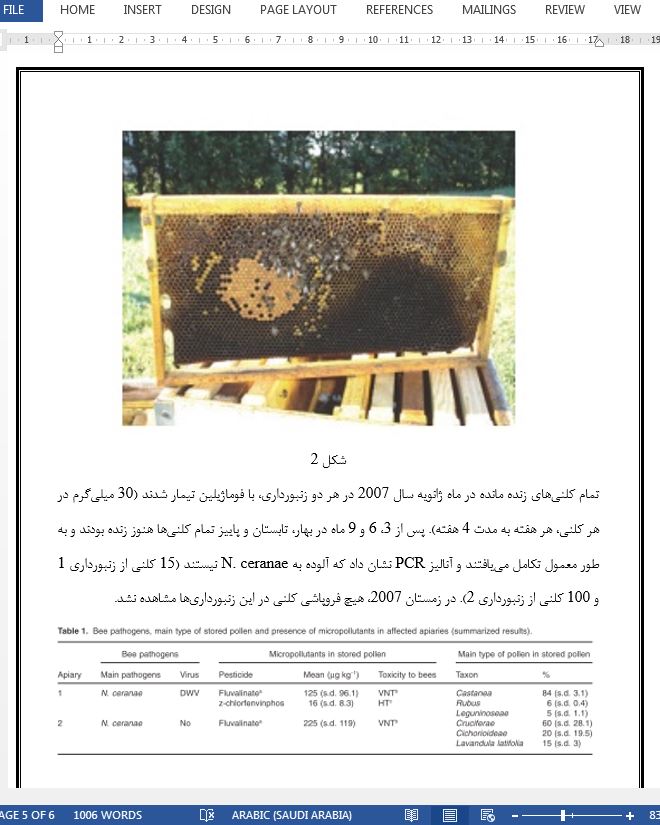| دانلود رایگان مقاله انگلیسی + خرید ترجمه فارسی | |
| عنوان فارسی مقاله: |
وجود Nosema ceranae در زنبورداری های حرفه ای و فروپاشی کلنی های زنبور عسل |
| عنوان انگلیسی مقاله: |
Honeybee colony collapse due to Nosema ceranae in professional apiaries |
|
|
|
| مشخصات مقاله انگلیسی (PDF) | |
| سال انتشار مقاله | 2009 |
| تعداد صفحات مقاله انگلیسی | 4 صفحه با فرمت pdf |
| رشته های مرتبط با این مقاله | کشاورزی |
| گرایش های مرتبط با این مقاله | زنبورداری، حشره شناسی کشاورزی |
| چاپ شده در مجله (ژورنال) | گزارش های میکروبیولوژی محیطی – Environmental Microbiology Reports |
| ارائه شده از دانشگاه | آزمایشگاه آسیب شناسی زنبور عسل، اسپانیا |
| نویسندگان | Higes M, Martín-Hernández R, Garrido-Bailón E |
| شناسه شاپا یا ISSN | ISSN 17582229 |
| شناسه دیجیتال – doi | http://doi.org/10.1111/j.1758-2229.2009.00014.x |
| رفرنس | دارد ✓ |
| کد محصول | 9320 |
| لینک مقاله در سایت مرجع | لینک این مقاله در سایت Wiley |
| نشریه وایلی | |
| مشخصات و وضعیت ترجمه فارسی این مقاله (Word) | |
| وضعیت ترجمه | انجام شده و آماده دانلود |
| کیفیت ترجمه | طلایی⭐️ |
| تعداد صفحات ترجمه تایپ شده با فرمت ورد با قابلیت ویرایش | 5 صفحه با فونت 14 B Nazanin |
| ترجمه عناوین تصاویر و جداول | ترجمه نشده است ☓ |
| ترجمه متون داخل تصاویر | ترجمه نشده است ☓ |
| ترجمه متون داخل جداول | ترجمه نشده است ☓ |
| درج تصاویر در فایل ترجمه | درج شده است ✓ |
| درج جداول در فایل ترجمه | درج شده است ✓ |
| منابع داخل متن | به صورت انگلیسی درج شده است ✓ |
| فهرست مطالب |
|
خلاصه مقدمه نتایج و بحث |
| بخشی از ترجمه |
|
چکیده فروپاشی کلنی زنبور عسل یک مشکل بهداشتی و زیست محیطی در سراسر جهان است. ویژگی های این سندرم شامل ناپدید شدن غیر قابل توضیح زنبوران بالغ، عدم مراقبت نوزادان، کاهش قدرت کلنی و مرگ و میر زمستانه سنگین بدون آشوب های پاتولوژیکی آشکار قبلی هستند. تا به امروز یک توافقی در مورد منشا آن وجود نداشته است. این گزارش ویژگی های بالینی دو زنبوردار حرفه ای تحت تاثیر این سندرم را توصیف می کند. شرح حال، بررسی بالینی و آنالیزها گزارش کرد که کاهش جمعیت در هر دو مورد، به دلیل آلودگی به Nosema ceranae (میکروسپوریدی) است، که یک عامل بیماری زای نوظهور برای Apis rnetutera است. هیچ پاتوژن یا آفت کشی (نئونیکوتینوئیدها) تشخیص داده نشد و جستجوگری زنبورها در مزارع ذرت و آفتابگردان مشاهده نشد. تیمار با فومیژیلین از کاهش زنده مانی کلنی های ضعیف جلوگیری می کند. این اولین گزارش از فروپاشی کلنی زنبورهای عسل ناشی از N. ceranae در زنبورداری های حرفه ای در شرایط مزرعه در سراسر جهان است.
نتایج و بحث |
| بخشی از مقاله انگلیسی |
|
Abstract Honeybee colony collapse is a sanitary and ecological worldwide problem. The features of this syndrome are an unexplained disappearance of adult bees, a lack of brood attention, reduced colony strength, and heavy winter mortality without any previous evident pathological disturbances. To date there has not been a consensus about its origins. This report describes the clinical features of two professional bee-keepers affecting by this syndrome. Anamnesis, clinical examination and analyses support that the depopulation in both cases was due to the infection by Nosema ceranae (Microsporidia), an emerging pathogen of Apis mellifera. No other significant pathogens or pesticides (neonicotinoids) were detected and the bees had not been foraging in corn or sunflower crops. The treatment with fumagillin avoided the loss of surviving weak colonies. This is the first case report of honeybee colony collapse due to N. ceranae in professional apiaries in field conditions reported worldwide.
Results and discussion The results of these analyses indicated that the only pathogen present in all the honeybee samples analysed was Nosema ceranae (Microsporidia) (as summarized in Table 1). The gross overview of the ventriculus showed them to be oedematous and friable, due to a strong epithelial cell infection, and with similar features to those described previously in association with N. ceranae infection (Higes et al., 2007; 2008b). There was evidence of epithelial cell degeneration and extensive lysis (Figs 3 and 4). As described previously (Higes et al., 2008a), the heavily infected cells may be either dead or dying, which will eventually lead to the early death of the infected worker bees due to starvation (Liu, 1984). This leads to the result that some heavily infected honeybees (foragers preferably) do not return to the hive and finally the depopulation of colonies is evident when the queen cannot compensate for the loss of foragers, depopulation becomes evident and death is forthcoming (Higes et al., 2008a).
|
|
تصویری از مقاله ترجمه و تایپ شده در نرم افزار ورد |
|
|
| دانلود رایگان مقاله انگلیسی + خرید ترجمه فارسی | |
| عنوان فارسی مقاله: |
وجود Nosema ceranae در زنبورداری های حرفه ای و فروپاشی کلنی های زنبور عسل |
| عنوان انگلیسی مقاله: |
Honeybee colony collapse due to Nosema ceranae in professional apiaries |
|
|
|
